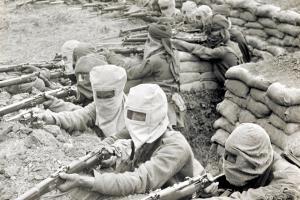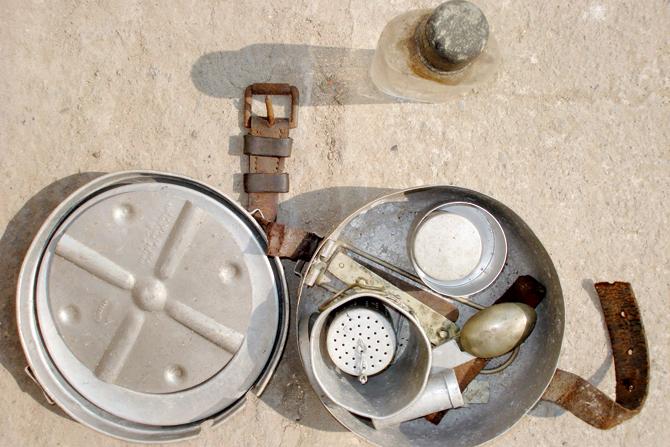The book begins with the complex reasons and motivations for Indian soldiers joining or being recruited into the Army

Indian Infantry from 58th Rifles training for gas attack. Pic Courtesy/The British Library Board (Girdwood Collection)
There is a story that Santanu Das, professor of English literature at King's College London, relays over an email interview, that if not immediately tugs at your heartstrings, might painfully stay with you. It's one that was shared by Punjabi novelist Mohan Kahlon. "Two of his great-uncles served in Mesopotamia [during the First World War]: one perished there, the other died on the voyage itself.
His grandmother went mad - clinically mad with grief - and their house in the village in Punjab came to be known as 'pagal-khana'," Das shares. Kahlon, who has also written a novel (Vahe Gaye Pani) about this, may have rendered this otherwise, haunting account to fiction. But Das brings it alive in a voluminous new title, India, Empire, and First World War Culture: Writings, Images, and Songs (Cambridge University Press), which recently released in the UK, and is available for pre-order in India.
ADVERTISEMENT

A tiffin- box and a German shell- case belonging to Captain Dr Manindranath Das in Mesopotamia, 1915. Pic Courtesy/Sunanda Das, Kolkata
The book, which is the result of over 10 years of laborious research with material from archives in seven countries, is the first-of-its-kind cultural and literary history on the "sensuous experience of combatants, non-combatants and civilians from undivided India" in the 1914-1918 conflict, and "their socio-cultural, visual, and literary worlds".
Between August 1914 and December 1919, India recruited for purposes of war 8,77,068 combatants and 5,63,369 non-combatants. Of these, 10,96,013 Indians served overseas in places as diverse as France and Flanders, Mesopotamia, East Africa, Gallipoli, Egypt and Palestine, Salonika, Aden, Persia and Central Asia, the book highlights. "The combatants did not just fight - they lived, loved and saw sunset glow; war is at once so much vaster and more intimate than names of battles and tally of medals. How did the men feel as they encountered new lands and peoples and experiences, how did they articulate their experiences and how does this story fit into the greater socio-political, cultural and literary history of undivided India? I realised just how important, powerful and immensely moving the story is - one million men largely consigned to oblivion - as well as the import of the war for India," says Das, of why he decided to pursue this war story.

Santanu Das
But, in trying to capture the texture of these men's experiences in the battlefields, hospitals and POW camps, he realised he had to go beyond the "textual". "I started looking at artefacts, photographs, sketches, paintings, sound-recordings, rumours, posters, periodicals, folksongs, and different forms of literature. For, in a world of fugitive fragments, literature fills in the gaps of history. In the book, I have tried to redefine the very scope and meaning of the 'literary'. First, a lot of the literature I have recovered - from recruitment verses and folksongs to qissas - would have been read out or performed orally: these men, I argue, might have been non-literate but intensely literary. Second, the 'literary' in the book is also a way of 'reading' a letter, an object or a photograph and trying to understand their various intensities of meaning," says Das, who is currently editing the Oxford Book of Colonial Writing of the First World War.
His book begins with the complex reasons and motivations for Indian soldiers joining or being recruited into the Army. As the narrative moves, we are exposed to the war writings that emerged from the battlefield - "from recruitment verses and witty limericks to those remarkable anti-war tracts with such visceral imagery, often matching up to the descriptive power of [Wilfred] Owen and [Siegfried] Sassoon, to those heart-breaking songs by women," as Das puts it - and therein, we are exposed to the pain of war, intermingled with abject homesickness.
Collecting the other war artefacts and memorabilia, was what Das describes a "combination of patience, persistence and serendipity". "I still remember that I was giving a paper on the subject at Plymouth and this lady turned up with a piece of fabric, with the image of the Taj Mahal threaded into it, and told me it was a gift from an Indian sepoy to her grandfather who served in the trenches. On another occasion, I was speaking about Jogen Sen at Leeds University, and a gentleman in the audience stopped me mid-sentence and pointed out that his name is on the memorial just outside," recalls Das. His own family history - three of Das's great-uncles served in the war - and museum archivists helped augment his research.
Sen's glasses, Mall Singh's voice, Manindranath Das's tiffin-box and Mir Mast's diary are not just fresh and tantalising sources, but open up new ways of 'reading' - and writing - life, and particularly colonial lives, in times of war, says Das, who will be releasing the book in India next month. "At an immediate level, they confront us with the role of the sensuous, the material and the contingent: they force us to weave together a narrative of fugitive fragments, the flotsam, jetsam and lagan of life wrecked by war; they point to the importance of relicts as zones of contact between warm life and historical violence. They not only congeal time, but also conceal processes of care: the fragility of the glasses, the wavering of the voice, the childish scrawl across the page, the crinkliness of postcard are in many ways the hand-prints and face-prints of war in the act of writing its own violent life. Moreover, at a historical level, they acquire an altogether new level of importance as source-material the moment we step outside the Western world," ends Das.
Catch up on all the latest Mumbai news, crime news, current affairs, and also a complete guide on Mumbai from food to things to do and events across the city here. Also download the new mid-day Android and iOS apps to get latest updates
 Subscribe today by clicking the link and stay updated with the latest news!" Click here!
Subscribe today by clicking the link and stay updated with the latest news!" Click here!







